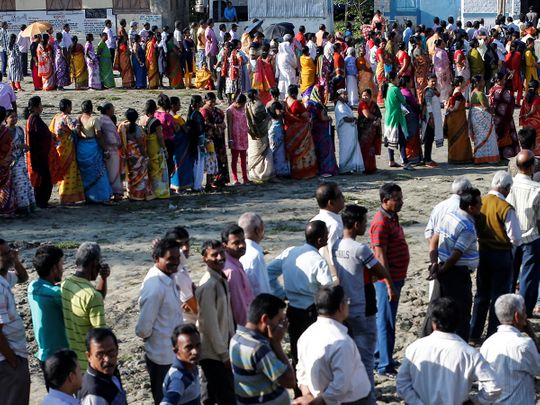
The second phase of the seven-part general elections in India got over on Thursday. A total of 38 Lok Sabha [lower house of parliament] seats in Tamil Nadu, 14 in Karnataka, 10 in Maharashtra, eight in Uttar Pradesh, five each in Assam, Bihar and Odisha, 3 each in Chhattisgarh and West Bengal, two in Jammu and Kashmir and one each in Manipur and Puducherry cast their votes.
The ruling BJP spokespersons said they were certain from the trends that their party would cross 300 seats in the 543-strong Lok Sabha.
It was not clear how they divined the figure from so early in the game. It doesn’t probably matter. It is not against the Election Commission’s code of conduct, a body of some pretension to moral rectitude: recently they reprimanded a politician who described a former actor and currently a BJP candidate, Jaya Prada, as a lady wearing ‘khaki underwear,’ alluding to her Rashtriya Swayam Sevak Sangh (RSS) leanings.
The RSS wears khaki shorts for their drills. The Congress, for its part, said they were confident of coming back to power. They too have divined trends endorsing their claims.
They pointed out that the South of India is virtually a forbidden area for the BJP. And that without the South, it would be hard for the BJP to get a majority.
The fact is, anything could happen. This election has brought sworn enemies together. On Friday, for instance, in Uttar Pradesh, the alluring prospect of power brought the leader of the Bahujan Samajvadi Party (BSP)— representing Dalits and other sections of the underprivileged — and the chief of the Samajwadi Party (SP) — representing the relatively better off Yadav caste — on the same stage for the first time since 1995. Soon after that year, the two leaders had fallen apart and were not on talking terms.
Changing loyalties
No longer. Nothing helps people to see the better side of each other than the prospect of spoils. Last week again, a prominent Congress spokesperson, Priyanka Chaturvedi, took offence at the “lumpen goons” who “misbehaved with her” and joined the Shiv Sena, a Mumbai-based local party with strong Hindu right wing views, and whose goon culture is only too well documented.
Reportedly, Chaturvedi wrote to the party president, Rahul Gandhi, about the “misbehaviour” of a few people and was disappointed by the lack of response. The very next morning, she joined the all too welcoming Sena. If anything, it indicates the move was planned well in advance. So much for values.
Once the results are out in May, we will see even more of these mercurial permutation combinations; unlikely alliances patched together by power and profit. All through this election, the Congress has claimed the moral high ground, donning the secular and liberal hats as opposed to the BJP’s nationalist Hindutva masks.
Yet the Congress may not mind coming to power with the support of, say, the feudally-run BSP and SP. Both parties are unabashedly caste-based.
The point is that expediency in Indian politics still holds the upper hand though this is India’s 17th general election. Profit and power still decide the destiny of the voter. Caste complicates it; class hardly figures in the equation. The Communist parties no longer can with any measure of justice say they represent the proletariat, for example, because even the working classes are organised more along caste lines — as the rising power of Dalit politics has shown.
Modi’s confidence
Indian Prime Minister Narendra Modi in recent speeches said by 2032 India would become a $10 trillion (Dh36.7 trillion) economy, behind probably just America and China. And that he has no doubt he would be PM for another term to facilitate the kind of growth that he envisages for India.
Even if this happens, the chances are that he would be heading a government that is conditional on the support of regional parties organised along the lines of feudalism, casteism and profiteering. That just means one thing: despite the tall talk of a $10 trillion economy, the ground realities of Indian politics have not changed over the years.
Nothing else explains the fact that most of India is heartbreakingly poor. The economy may be growing. But the growth is clearly concentrated in the hands of a few oligarchs. According to reports, the top 10 per cent of the elite owns 77 per cent of India’s wealth.
No matter what a vibrant democracy India is reputed to be, a political system that does not much care to narrow the gap of income inequality is not a fair one.
The strange realignments — individually and party wise — that India is seeing as May approaches are in keeping with a certain pattern of power formation. Unfortunately, the poor as a class have not yet found their proportionate representation in India.
The thing to do perhaps is to increase the vote value of those below a certain annual income. If one very poor Indian voter has twice the value at the ballot, the power equations will change along class lines.
People like Priyanka Chaturvedi just might form her own Party of the Poor. And others may follow suit.
C.P. Surendran is a senior journalist based in India









